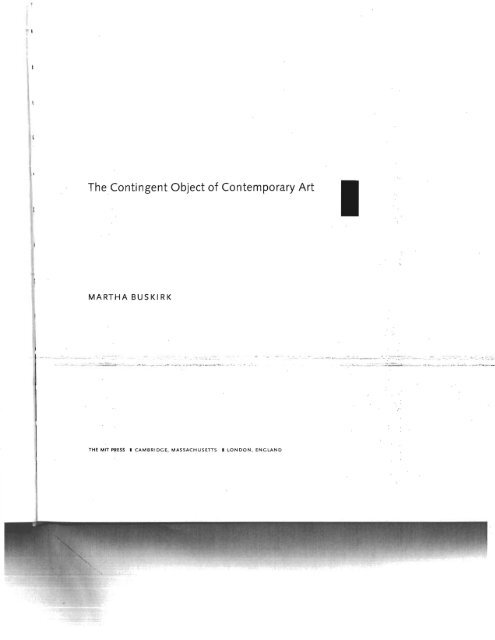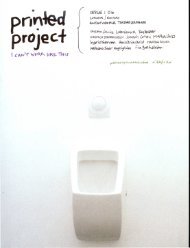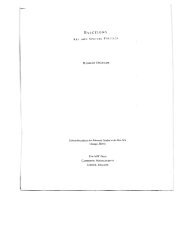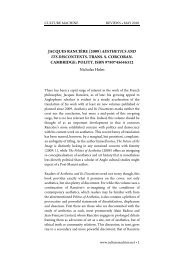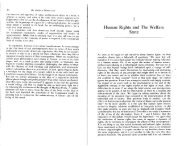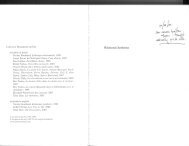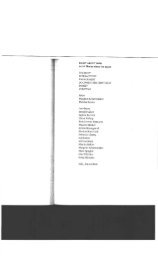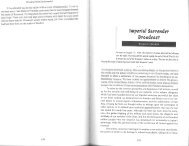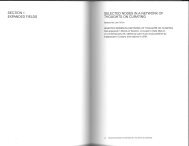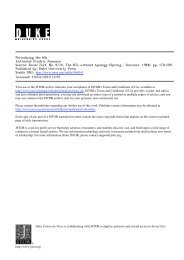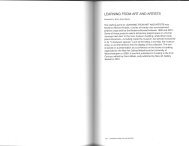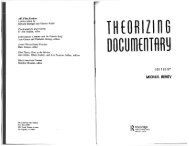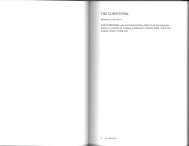Martha Buskirk, ""Authorship and Authority"" - doublesession
Martha Buskirk, ""Authorship and Authority"" - doublesession
Martha Buskirk, ""Authorship and Authority"" - doublesession
Create successful ePaper yourself
Turn your PDF publications into a flip-book with our unique Google optimized e-Paper software.
TheContingent Object of Contemporary Art<br />
MARTHA BU S KI RK<br />
_. -.::- .:<br />
........ - ,,"..... ..... .. ,. ... .-.<br />
THE MIT • (AMBRIDGE, MASSACHUSETTS. LONDON, ENGLAND<br />
-_...., -- .....<br />
_.... ._.... ......; ; ----,<br />
.... _ _ _
ONV
I remember very clearly the drama ofmy third visit to the Dia Center exhibition ofRichard<br />
Serra's Torqued Ellipses. The space was completely taken over by three large volumes<br />
formed from curved sheets ofsteel that tilted both inward <strong>and</strong> outward to varying degrees<br />
<strong>and</strong> according to different rhythms. On two earlier occasions, once by myself <strong>and</strong> once<br />
with a group ofstudents, I had walked around the exterior <strong>and</strong> interior ofeach ofthe three<br />
forms in turn. The constantly shifting incline oftheir twelve- or thirteen-foot-high walls of<br />
steel induced a feeling close to vertigo, <strong>and</strong> in the Double Torqued Ellipse the sense ofbeing<br />
kept off balance was even more pronounced within the narrow passageway established be-<br />
tween the exterior <strong>and</strong> the second set ofplates that formed an inner enclosure. In the strong<br />
light pouring down from above, the unfolding experience ofthe different spaces was com-<br />
pletely linked to the materiality <strong>and</strong> varying tonalities ofthe rusting surfaces of the steel,<br />
surfaces that were unavoidable as they closed in around anyone willing to enter the quiet<br />
menace of the heavy forms.<br />
H was with the anticipation ofa repeat encounter that I stopped in at the end ofa sub-<br />
sequent trip to Chelsea. Since my previous visits had taken place in the middle of the day,<br />
I had not noted the a_bsence of artificial lights in the space. But my perceptio!.l ()f the work<br />
changed dramatically when the· illlHTIination from the skylights faded. As the room<br />
dimmed, surface, color, <strong>and</strong> detail were taken out of the equation, to be replaced by the<br />
overall apprehension of masses, darkly silhouetted in the remaining light, enclosing am-<br />
biguous interior spaces. So dramatic was this transformation that the Torqued Ellipses I was<br />
experiencing could have been a different work.<br />
No work of art is immune to the circumstances of its presentation. Nor is it an un-<br />
common experience to find soine new quality or detail in a work of art that one has seen<br />
many times. Part of the power of works of art that bring one back time <strong>and</strong> again is that<br />
<br />
'-.
Richard Serra. Torquul I,<br />
Torqutd EI/ipw II, both 1996, <strong>and</strong><br />
DOllbl. Torqu.d EIIipS$, 199J-<br />
Wt:alherproof sttoel, .." dimensions<br />
12' x 29' x 10' 5-, 13' 1· x 29' ,,"<br />
x 20' 7", <strong>and</strong> 1]' ,. X 3]' 6" x 2]' ,'.<br />
Instali,uion at Dia tne<br />
Arts, New yorit. COUlUty the artist.<br />
, I<br />
.j I<br />
!<br />
surprise in the midst ofthe familiar. But the degree to which the surrounding environment<br />
frames this work establishes a form of contingency that can have a profound impact on<br />
how the work is understood. Nor is it just the object <strong>and</strong> the surrounding space that are in<br />
play. because the otber actor is the viewer, mobile <strong>and</strong> experiencing the work as a series of<br />
encounters. The body is thus present, not as sculptural representation, bUI<br />
rather in the afthe spectator whose movement through space is framed <strong>and</strong> marked<br />
by abstract fonn.l<br />
Although Serra's emphasis on materials <strong>and</strong> process as well as the complexity of his<br />
forms move his work away from some of the characteristics identified with minimatism,<br />
both frame an experience ofspace <strong>and</strong> time·in which one's visual perception of the work<br />
cannot be separated from one's bodily underst<strong>and</strong>ing ofits presence. The focus on the en-<br />
tire experience generated by the work was critically articulated in response to the relatively<br />
simple shapes that one finds in the work of Donald Judd, Carl Andre, <strong>and</strong>, for a period,<br />
Robert Morris, or the arrangements ofst<strong>and</strong>ardized Ruorescent fixtures by Dan Flavin. The<br />
literal shape of (he minimalist object depended on the use of industrial means of produc-<br />
tion, the creation ofobjects based on simple geometric forms conceived in advance of their<br />
realization, the incorporation ofthe copy in the creation ofwork based on repetition or se-<br />
rial forms, <strong>and</strong> the use of prefabricated units like bricks or fluorescent fixtures. This use of<br />
st<strong>and</strong>ardized industrial materials <strong>and</strong> forms contributed to the nonan look that Michael<br />
Fried aptly described in his classic condemnation of minimalism's theatricality, while<br />
many ofthe same qualities were read by Rosalind Krauss as a powerful activation of cxre-<br />
riority<strong>and</strong> the phenomenological unfolding of the viewer's experience in time <strong>and</strong> space. 2<br />
One reason why every nuance of the intersecrion between object, surrounding space)<br />
<strong>and</strong> viewer's experience takes on such importance is that so much has been excluded from<br />
the work. The "cool" quality that early critics found in minirnalism came from the smooth,<br />
untouched surfaces ofthese simple shapes. The deceptive simplicity that inspired the label<br />
of minimalism-which stuck. over theobje.ctions ofthe artists-led some to focus on ideal<br />
form at the expense ofthe specific material realization. What the work excludes is evidence<br />
of the an.is4 of an author's touch in its formation. In his retrospective assessment of this<br />
tendency, however, Hal Foster has argued against readings of minimalism as ideal form,<br />
insisting on the importance ofdistinguishing between "the purityofconcep[jon" <strong>and</strong> "the<br />
contingency of perception.") Foster, citing Rol<strong>and</strong> Barmes., links this death ofthe author<br />
to the birth of the viewer. 4 DougJas Crimp makes a similar argument, atuibuting the <br />
ponance of the spectator to minimalism's '"'attack on the prestige of both artis( <strong>and</strong> an-<br />
work...'" The degree to which traditional markers of the artist's presence have been<br />
removed from the minimalist work can be connected to significant features ofauthorship<br />
1 AUTHOItSI-l ... A .... OAUTI-IOItITY l.l':I]<br />
'\
i<br />
described by Michd Foucault as a system ofclassification based on J 'e usc ofthe author's<br />
name to'designate <strong>and</strong> differentiate among works.' . t<br />
However. it is aNWld the function of authorship that the become more com-<br />
plicated. On the Qnc h<strong>and</strong>, there is the ,ip in minimalism's<br />
seemingly untouched surfaces; <strong>and</strong> this withdrawal of touch 'waiho just an 'effect, given<br />
the widespread use <strong>and</strong> ready-made components. 'e long-tenu history<br />
ofthis work tells another story about one conceming'jbe a:rtist's ongoing con-<br />
nection to the work, expressed in efforts to control context <strong>and</strong> Plicemfnl. Th,is history in-<br />
cludes an often built-in legal requirement for collectors <strong>and</strong> in$tirutions to consult the<br />
artists on issues ranging from placement to replacement ofparts, Jnd ofits expressions<br />
is the use of wrinen contracts. certificates, <strong>and</strong> other forms of instruction to accompany<br />
the work. Read in this light, minimalism's history subsequent its initial appearance-<br />
the story of its with collectors <strong>and</strong> institutions-requires an analysis of the inter-<br />
seCtlon of authorship <strong>and</strong> ownership.<br />
Over a work's history, decisions about how it will be presented necessarily determine<br />
the spectator's experiential underst<strong>and</strong>ing of it, In the case of work mac:k from unfixed or<br />
changeable elements, interpretation is not simply a maner of a possibly varied response to<br />
an essentially stable physical object; instead, a prior stage of interpretation can have dra·<br />
matic implications for the configuration of the object to be perceived. Furthermore, the<br />
of interpretation that shapes decisions about display as well lo ng-term care <strong>and</strong><br />
preservation is frequently presented as a reading ofanistic intent-a' reading based on as-<br />
sumptions abom the artist's common practice as well as wrinen <strong>and</strong> related<br />
documentation. Over the life of a work. questions about display <strong>and</strong> preservation require<br />
an interpretation ofexactly what constitutes the work <strong>and</strong> who is authorized to make de-<br />
cisions that will shape how it is received, The answers are not neces5aqly obvious for works<br />
that depend on establishing a specific relationship to ever-changing <br />
My third experience of Torqued Ellip,esconstituted a dramatic chi/nge. Though neither<br />
the materiality of the work nor its placement within the SUrTouriding physical space were<br />
altered, the sh.ift in lighting created radically different viewing condi,tions, But what hap-<br />
pens if the object itself is also contingent, subject to shifts in materiaJ't:>r configuration over<br />
time?"Abeaman its end is not the same as the same beam on its.side;,'" wrote Morris in his<br />
"NOles on Morris explored this idea in the vntb simple straight or<br />
l-shaped beams'shown simultaneously'in different several exhibitions<br />
where he introduced as part of h.is for grOLtPinp of <strong>and</strong><br />
wedge-shaped forms Or, slightly later, a room piled WIth At other urnes', the<br />
materials will alter over time, wheth'er such change is desired or the experience of<br />
I :<br />
I<br />
I<br />
I<br />
<br />
, .<br />
. .<br />
the work will be transformed by differences in the work's appearance. While the dramatic<br />
yeUowing of Eva Hesse's works in fiberglass <strong>and</strong> the brittle discoloration or complete decay<br />
of those made from latex may have been predictable, the consequences have been extreme<br />
for the ongoing appreciation of the work. Yet even these: examples involve demonstrable<br />
changes 10 the physical object. An object that is nOl self-contained but depends On its rela-<br />
tion 10 the surrounding space can be subject to more ambiguous changes from shifts in the<br />
relationship of components to one another or to their environment<br />
Judd's famous description of composition based on «one thing after another" found<br />
its articulation in serial progressions that are sometimes physically linked, <strong>and</strong> at other<br />
times are made up of independent units that only come together in the moment of their<br />
exhibition <strong>and</strong> essentially cease to funct io n as a work of art when nOl arranged for display.'<br />
While it may be difficult to see <strong>and</strong> therefore a painting when it has been badly<br />
lit, one doesn't tend to think that the object itseU"has changed, whereas works involving<br />
components arrayed on the floor or walls ofa room depend on their arrangement for their<br />
impact on a viewer. How much compromise or deviation is allowed, then, before the re-<br />
sult is a failure of the work, or of authorship? The rearrangement of components could<br />
constitute a new work. Or simply no work. when their layout diverges from the One estab-<br />
lished by the artist<br />
Work that is dependent On its conteXl is in a certain sense nOt finished until it is acru-<br />
ally on exhibition. Nor is it definitively set just because it has been exhibited <strong>and</strong> even sold.<br />
The issues surrounding the future of a work of art may not be of much concern the first<br />
lime the work is exhibited, particularly if the artist is only just becoming known <strong>and</strong> col-<br />
lected, It is only with the establishment ofa market for t.heir work that artists are forced to<br />
concern themselves with the life of the work over time, as it enters sicuarions that the artist<br />
did not select <strong>and</strong> may not be able to control. Given the degree ofinterconnection between<br />
the minimal object <strong>and</strong> its physical space, perhaps it shouJd not be surprising that minimal<br />
an has seen some of the more vigorously argued confrontations between artists <strong>and</strong> other<br />
individuals or instirutions over the collecting <strong>and</strong> display of their work. The embrace of<br />
such works by collectors <strong>and</strong> museums brings up not only the importance ofplacement in<br />
relation to a space, but also conservation issues involving the possible exchange or re-<br />
placement of elements. The sale of works on the basis of plans raises even more funda-<br />
menIal issues about the extent to which the artist is willing to delegate decisions about the<br />
work's realization. The potential malleability ofthe relationship between object <strong>and</strong> envi-<br />
ronment, or. at a more basic level, the question of who is authorized to realize a work,<br />
forces considerarion of how much control artists can continue to exercise over<br />
the conditions ofdisplay for their works, <strong>and</strong> by what means they retain that control. The<br />
1 AUTHOIISH"ANDAUTHOIIIITY 2.4 ' 2S
absence of the artist's h<strong>and</strong> or touch also bas a corollary in a greater emphasis on exterior<br />
evidence afthe work's authenriciry. The extemalization ofevidence tioth of artistic intent<br />
<strong>and</strong> of gives rise to a somewhat paradoxical situation: inlwhich the long-Ieml<br />
existence ofthis poysically comm<strong>and</strong>ing work turns on issue.s .<br />
The oflanguage is not give\} degree to which the<br />
artists associated with minimalism were active in the critical discoJrse\'fthe period. In fact,<br />
Fried opened his attack on minimalism's theatricality by worlculargely ideo-<br />
logical," an enterprise that "'seeks to declare <strong>and</strong> occupy a that can he formulated<br />
in words. <strong>and</strong> in fact has been fonnulaled by some of its-leading practitioners.u,<br />
Somewhat laler. Craig Owens ascribed a less secondary role to statements that used lan-<br />
guage nOI as description. but in ways that paralleled the aspect of the work.lO<br />
Language is also implied in the connection to the enunciative sratement ..this is an" that<br />
Thierry de Duve has posited as a condition ofthe readymade."<br />
Many ofthe significant documenlS, however. lack the visibility ofthe artislS' published<br />
statements, necessitating a consideration of the institutional conventions through which<br />
claims ofauthorship for serially fabricated works are secured <strong>and</strong> administered. The lan-<br />
guage of instructions. cenificates, <strong>and</strong> contracts may seem to have Unle relevance for the<br />
experience ofa work ofart; yet the passage oftime only increases the importance ofthis in-<br />
terpretation that generally takes place out ofsight. Seemingly, a cenificate of authenticity<br />
issued by an artist would be secondary to the object being so described. In fact, such con-<br />
ventions became central to conceptual art, with an early example in Mel Bochner's "Work-<br />
ing Drawings <strong>and</strong> Other Visible Things on Paper Not Necessarily Meant [0 Be Viewed as<br />
Art," • 1966 exhibition he curated for the School ofVisual Arts in New York. The<br />
installation consisted of four binders filled with photocopies df preparatory drawings,<br />
plans. proposals, <strong>and</strong> even receipts solicited from artists, architects, composers, <strong>and</strong> oth-<br />
ers. Ahhough Bochner's title left the status ofthese documents open, hjs indusion ofdraw-<br />
ings <strong>and</strong> other material from anists who made use ofoutside fabricat,ors in the production<br />
of their work was an early indication ofa point of intersection between issues ofproduc-<br />
tion for artists associated with minimalism <strong>and</strong> questions con-;erning the nature of the<br />
work that would be raised by conceptual artists. I) It was precisely 'an: of linguis·<br />
tic conventions <strong>and</strong> legalistic arrangements,'" Benjamin Buchloh ha.s argued, that distin-<br />
guished conceplual art from the "aesthetic of production <strong>and</strong> consuinption" he identifies<br />
as characteristic ofpop art <strong>and</strong> minimalism.ll The question that has to be examined, then,<br />
is what [he implications arewhen these conventions also functi0Iljas conditions<br />
in the production <strong>and</strong> marketability of minimal art.<br />
To what extent is the idea separable from its specific <strong>and</strong> how<br />
much lalitude can there be in [he material object for it to constitute '" expression of that<br />
idea? Does the work of authorship lie in the material object, or in the plans <strong>and</strong> instruc-<br />
tions for its realization? Ifthe anisl has the power to declare an object to be a work of an,<br />
[0 what extent does the artisl have the power to revise that declaration, <strong>and</strong> to what extent<br />
is that power ofdeclaration transferred wilh the sale of the work? These considerations are<br />
typlca1Iy the province of conceptual rather than minimal art. Nonetheless the relatively<br />
disembodied realms ofwritten words <strong>and</strong> diagrams are enmeshed with work that is about<br />
a particular kind of physical experience. No single answer can be given to the qUe51ion of<br />
wh.ere the "work" resides, since the answers vary, even within the approach taken by indi-<br />
vidual artists. One way to start to consider the nature ofthis form ofauthorship, however,<br />
is in the moments when it has become contested.<br />
The withdrawal ofauthorship as a form of protest was Andre's response to a series of<br />
decisions by the Whitney Museum following the museum's request to borrow Andre's 1975<br />
Twelfth Copper Corner for its 1976 exhibition "100 Years of American Sculpture." The<br />
piece. a( the time still owned by Andre, was one ofa series consistingof50 cm x 50 cm cop-<br />
per plates set into the corner of a room in descending rows such that the overall shape is a<br />
right triangle with a jagged-edge hypotenuse. Because the plales extend only 0.5 em above<br />
the height of the floor, the work is sculptural due to its orientation rather than its actual<br />
volume. It is a work that requires a particular kind ofspace as weU as arrangement, <strong>and</strong> in<br />
relation to the verticality of the spectator the work lakes control not only of the ftoor) but<br />
also ofthe column ofspace that extends above the array of plates. For the exhibition at the<br />
Whitney, Andre initially participated in the selection ofa space within the galleries. Later,<br />
however, the work was moved from the location he had chosen to a corner where it had to<br />
compete wlth a window <strong>and</strong> an emergency exit door, <strong>and</strong> Andre withdrew the loan. The<br />
Whitney then replaced the withdrawn piece with a work from the pennanenl collection,<br />
Andre's 1975 Twenty-Nimh Copper Cardjnal, which also consisted ofan arrangement of<br />
plates. in this case a row of units determined by a cardinal number extending out from a<br />
wall. The museum, however, decided to instaU the work with a rubber mat underneath in<br />
order to compensate for the uneven flagstone floor on which it was placed. 1 •<br />
For most ofan, the placement ofa work thai an anist no longer owns is gener-<br />
ally assumed to be outside the artist's control. However, the arrangement of elements isan<br />
integral part ofAndre's work. Presumably the colJectors<strong>and</strong> institutions that own his work<br />
also underst<strong>and</strong> that the effect ofthe work dependson its placement within the space ofthe<br />
room, with no pedestal or platfom1 separating the work from the viewer. But for Andre, to<br />
interpose any material between the work <strong>and</strong> [he floor was also a transgression. Andre's<br />
response was to offer to buy back the Whitney'swork for $26,000, one thous<strong>and</strong> more than<br />
the purchase price. After this tender was rejected, he reduced his offer to 70 cents per<br />
pound for the scrap metal, <strong>and</strong> he mounted a counterexhibilion at 355 West Broadway in<br />
A.U1HOItSHIP AUTHOIiITT 26· Z7
;'0- _ '"
which he displayed not only the Twelftl, Copper Comer but also i) competing version of the<br />
Twenty-Ninth Copper Cardinal that he designated as the original, "liberated,", the invi·<br />
tation declared, "from property <br />
The Whitney initial of the ind.ustri-<br />
ally' produced elements, but resollllely ignored his redesignatioh ofauthorship to another<br />
physical object. Apparently not doubting the permanence of its title to the work, the mu-<br />
seum continues to list the work as pan of the collection. Perhaps the curators simply did<br />
not doubt the work's continuous material existence. Yet the piece is also included, without<br />
any obvious irony. in a subsequent catalogue of collection works entitled Immarerinl Objere.<br />
While the catalogue does not make any reference to the controversy, it does repro-<br />
duce the certificate Andre provided with the work.. 16 These sheets, st<strong>and</strong>ardized by Andre,<br />
record basic facrual information about a work's specifications <strong>and</strong>' history that could be<br />
misconstrued as a kind of recipe were they not dearlysecondary to In this sense,<br />
the Whimey has used one statemenl by the artist, a piece of paper which he confirmed<br />
this particular group of metal plates to be the work, in order [0 retute other subsequent<br />
declarations by Andre. The publication. of the certificate alongside the installation photo-<br />
graphs suggests that it is the museum's possession of the original sheet of paper. as much<br />
as the original metal plates, through which they affirm their of a work of art<br />
rather than a pile of scrap metal.<br />
In 1976 a controversy also erupted in Engl<strong>and</strong> when the press out about theTate<br />
Gallery's purchase ofAndre's Equivalent VIII. The work that had acquired in 1972<br />
was one of eight rectangular configurations made from 120 bricks layered two deep. The<br />
original group of Equivaienu comprised Andre's second solo $how in New York in 1966,<br />
<strong>and</strong> their arrangement. dispersed across the space of the gaUery with room to walk in be-<br />
tween, was an early example ofAndre's relatively horizontal forms to take control of<br />
an environment. What the.anention of the British press, was the fact that<br />
the Tate had spent a large sum of money on an arrangement <strong>and</strong>, additionally,<br />
that the bricks which constituted the.work when it was sold to thetate were not the same<br />
bricks that Andre had used when he first the work.. U tlelogic of the piece was<br />
based on a st<strong>and</strong>ardized unit that could be r.eadHy replaced" sfh ' :ck of concern for the<br />
specific ph)"ical object none\heless goes against long-held assujnp· ons about the work of<br />
art. It is therefore telling that catalogues of work give: twt dates <br />
I-VI<strong>and</strong> VIII: "New Yorkl966 (destroyed) I New York 1969 putting into art-<br />
. . I<br />
historical language the fact that replal;:ement bricks, were for all but Eq'fiYalenr V1J."<br />
A rather diff-ere'nt j'mpulse seems to h'ave motivated the yet another version<br />
of EquiYaienrs, In 1995 the Gagosian Gallery exhibited a re-creafiori of the work: under the<br />
I .<br />
I,<br />
! .'<br />
title S<strong>and</strong>-Lime Instar, <strong>and</strong> the 1969 date dropped away in the listing "destroyed 1966/ <br />
made 1995. '" The gallery provided several justificat.ions for yet another remake of a work<br />
lhat had already been made, remade, <strong>and</strong> sold. One reason was the dispersal of the earlier<br />
elements, <strong>and</strong> another, surprisingly. was the fact that the second version had acruaUy not<br />
been made from lhe right bricks, since Andre had bought firebricks in 1969 rather than<br />
the s<strong>and</strong>·lime bric.ks used in the original: "All but one ofthe original Equ;yalents were<br />
destroyed; the others were remade in firebrick in 1969. These works have been dispersed,<br />
S<strong>and</strong>-Lime Instar is thus the final Equ;yalent, the ninth 'work': the installation <br />
Where the bricks were initiaJiy treated as interchangeable, arguments for the later version<br />
invoke claims ofstrict historical accuracy. But the wrong brides also have a certain priority,<br />
since they were authorized by the artist at a time dose to the work's inception. Perhaps<br />
the more important issue was the difficulty that the scattering of elements would have pre-<br />
sented to organizers ofa 1996 retrospective where the work was exhibited. Hesse regretted<br />
a similar decision to disperse the units that made up her 1968 Sans II, a fiberglass relief<br />
made from double rows of shaUow boxes that presents a purposely eccentric version of<br />
minimal repetition. In Hesse's case, not only was her largest work separated, but because<br />
of its dispersal the fiberglass units have subsequently yellowed at varying rates-wilh the<br />
differences in their relative condition a,ll too evident when they appeared reunited in the<br />
2.002 retrospective ofHesse's work. 20 The inconsistency i.n the bricks used for the eight dis-<br />
persed Equivalentswould have meant that their reunion wouJd be marred by a conceptual<br />
inconsistency in some respects more acute than differences in condition. Regardless of its<br />
accuracy, however, the recent re·creation would be no more than a replica were it not for<br />
the artist's renewed assertion ofauthorship.<br />
The history of art is tilled with examples ofartists who rerurn to <strong>and</strong> reinterpret their<br />
earlier ideas, The question, then. is what the difference between a reinterpreta-<br />
ti,on <strong>and</strong> a simple repetition. Art world customs driven by a market based on raricy insist<br />
on the distinction between a unique work <strong>and</strong> work produced in an edi[ion. The conven-<br />
tion ofthe limited edition developed i.n response to the inherent muJtiplicity of mechani-<br />
cal reproduction, as opposed to the assumed uniqueness of the h<strong>and</strong>-painted origjnal. For<br />
works tha[ could, seemingly. be duplicated, the artist's authorization provides the most<br />
significant djifere'!tiation or limit on production. Given the market imperative to control<br />
multiple copies; the existence of more than one authorized version ofa work can have sig-<br />
nmean't consequences.<br />
In an unusual,instance a h<strong>and</strong>-painted original that was also a copy, Frank<br />
was taken to court by coUectors Donald <strong>and</strong> Lynn Factor when they learned of an-<br />
other version ofStella's 1960 Marquis de Porrago. The work was part of Stdla's first series<br />
1 AUTlotO.tsH' .....NO ...uTHOA.n 30 ' Jl
EVil Hesse, Som II, 1968 (two<br />
unin). Polyester ruin .lnd fiber·<br />
SlilSS, 38' x170" x 6Jo{,", Whitney<br />
Museum of Amenciln Ast, New<br />
York. Reproduced wirh die permission<br />
of the Estille of Eva Hesse,<br />
Galerie Hauser & Wirth, Zurich.<br />
11<br />
I <br />
f <br />
I I<br />
"<br />
. .<br />
of shaped canvases, painted with alwninum paint on notched rectangular supports. The<br />
combined effect of their shaped surfaces, relatively deep stretchers, <strong>and</strong> tPe industrial alu-<br />
minwn paint used for their parallel stripes is the eHmination of traces of illusionism in the<br />
21 Furchermore, the pa.intings are conceived in advance oftheir execution,<br />
<strong>and</strong> absolute unity of composition <strong>and</strong> suppon contributed to Judd's inclusion of<br />
Stella in his description of "Specific Objects" that he praised for being "neither painting<br />
nor sculpture. on<br />
It the existence of another version of Marquis de that the Fact':'Ts blamed<br />
when the reserve on the painting was from to $15,000 when it was put up<br />
for, in 1970 (where it sold for 517,000). The painting that the Factors purchased was<br />
actually the second version of the work, done in a lishter aluminum painL Stella painted<br />
two versions each of his three alwninwn paintings. using an identjcal fonnat but<br />
changing from a darker to the slightly lighter shade that he then used for the remainder of<br />
the eight configurations in the series. But the history of the Factors' paiming was still more<br />
complicated. Theirwork was damaged. in 1964. <strong>and</strong> Stella agreed to repaint it, which he did<br />
in 1965 wing a third type ofpaint. Caroline Jones quotes Stella to the effect that "people in<br />
California are only interested in perfection"' as the reason why he completely repainted the<br />
work.21 The Factors returned the damaged work to Stella. <strong>and</strong> they believed that it was their<br />
work, subsequently restored, that was in the collection of Caner Burden. Although Stella<br />
did evenlually restore <strong>and</strong> sell the second version ofthe painting, the workin Burden's col-<br />
lection was the first version. In deciding the Stella case, the court found that "'an anist has<br />
a duty to a purchaser of his work to inform the purchaser of the existence of a duplicate<br />
work which would materially affect the value or marketability ofthe purchased work." The<br />
other complications, however. led the judge to conclude that there was no evidence that<br />
the value of the work had been compromised. <strong>and</strong> therefore to decide in favor of Stella on<br />
the question of <br />
Stella obviously painted the copyofhis own work without intending to emphasize the<br />
paradox that Robert Rauschenberg made the subject ofhis play on the repetition ofthe ap-<br />
parently spontaneous gesture in his 1957 Factum I<strong>and</strong> Faaum llt but what is interesting is<br />
that they were perceived by the collectors as beingsuffic.ient1y similar in plan that the differ-<br />
ent versions were merely repetitions of one another rather than different interpretations<br />
by the anist. In response to a question posed by Bruce Glaser. Stella addressed the process<br />
of interpretation involved in moving from a plan to a painting: fAA diagram is not a paint-<br />
ing; it's as simple as mal. I can make a painting from a diagram. but can The re-<br />
painted version that became the source of contention does look quite different from the<br />
first version. The fact that the third version ofthe work was painted with the type of metallic<br />
1 AUTHOIUHIP .... NO .... UTHOIIIT'Y ]2, 33<br />
Ffilnk Stellil, Marquis d, Portogo<br />
(second version). '960. Aluminum<br />
oil pilint on Qnvas. 7'91," x 5'11Y,".<br />
e 1001 Frilnk Stella I Arusts Rights<br />
Sooety (ARS), New York.
paint that Stella was using in 1965 also shows how his own interpretation of the diagram<br />
changed over time. so that rather than being a duplicate of a work based on the same com·<br />
position, it was a new interpretation of that idea based on the artist's sh:ifting aesthetic con-<br />
cerns, These questions about how much one of a might differ<br />
from the next. <strong>and</strong> the potential separation between plan <strong>and</strong> executi.on, took yet another<br />
peculiar twist when SteHa's work became the subject of a pseudonrmous parodyartide entitled<br />
"The Fake as More," included in Gregory Battcock's 1973ltka Arr. concerning copies<br />
of Stdla's work by the imaginary artist Hank Herron described as identkal to Stella's originals<br />
in appearance, yet entirely different in content" '<br />
Works produced by methods that employ rather than simply suggest industrial man·<br />
ufacture may be accompanied by wrinen confirmation of the ,work's authenticity <strong>and</strong><br />
uniqueness. The history of a work-its provenance-has long provided. important evidence<br />
of authenticity. even for works that bear marks of the artist's h<strong>and</strong>. As internal or<br />
material evidence of a work's hiscory is lessened. however. external measures are increasingly<br />
important. For Giuseppe Panza, the Italian collector who amassed a significam collection<br />
of postwar American art particularly notable for the minimal <strong>and</strong> conceptual works<br />
that he purchased early <strong>and</strong> often in great depth, issues of were especiaUy<br />
crucial. The importance of these documents was later high1ighte,d bO,th by his public disagreements<br />
with several artists represented in his collection <strong>and</strong> by questions about the status<br />
of some of the works included in the sale of his extensive "9llection of minimal <strong>and</strong><br />
conceptual art to the Guggenheim Mus,eum. It was not just a ma'!1er of having certificates<br />
to substantiate the authenticity of objects that did not carry evident traces of authorshipi<br />
I"<br />
in a number of instances the piece of paper'was the only evidenclofPanza's possession of<br />
,<br />
the work,<br />
Panza's collecting habits give new meaning to the description uJ.orkson paper," since<br />
many of the works in his coUection acquired on the basis o{ pl.ins than extant<br />
physical objects. archjves. now housed in the SpeciaJ Coliectiqns division of the tlbrary<br />
of the Getty Research Institute, are filled with various of certificates an'd<br />
agreements <strong>and</strong> the traces of his efforts to secure such such<br />
certificates <strong>and</strong> other forms of authentication are increasingly they are much more<br />
rarely reproduced. The publications <strong>and</strong> documents surrounding Panza's collection provide<br />
the most revealing window onto such addition: to charting Panza's own<br />
growing concern for this documentation. his archives also reveal some of the steps taken<br />
by artists in his collection to organize <strong>and</strong> regularize their own. such documents.<br />
Panza's resolve to have documentation certifying the WOfks -in his collection was<br />
clearly strengthened by an early incident involving Bruce Nauman's projects for various<br />
types of installations, In a 1971 letter, Douglas Chrisnnas of Ace Gallery made passing reference<br />
to plans for two versions of Na.uman's installations, one for the North American<br />
market <strong>and</strong> one for Europe, Pama responded to this information with urgent leners to<br />
galleries <strong>and</strong> Nauman himself expressing alarm at the idea that he did not have<br />
exclusive rights in the works he had purchased in the form of plans, The result was a decision<br />
by Nauman's dealers not to pursue the sate of multiple versions, <strong>and</strong> assurances from<br />
Leo Castelli that all of the works Panza had purchased would remain unique. The Castelli<br />
Gallery also provided Panza with certificates for several works in the form of photographic<br />
documentation signed on the back by the artist. 27<br />
Starting in 1974> however, Nauman aJso signed a series of typed c.e.nificate5 for the installations<br />
that panza had already purchased in plan, with the main provisions contained in<br />
three sentences that declare Panza to be the owner of the work, that entitle him to reaJ.i.ze<br />
<strong>and</strong> to assign the right to realize the work., <strong>and</strong> that guarantee the following: "I certify that<br />
the above work is my original <strong>and</strong> unique creation, <strong>and</strong> 1undertake not to do. realize. sell,<br />
or authorize the !arne work." (In fact Nauman canceled out the last five words of the stalement,<br />
which originally called on the artist to make a remarkably broad promise to Panza:<br />
"I certify that the above work is my original <strong>and</strong> unique creation, <strong>and</strong> 1undenake not to<br />
do, realize. sell. or authorize the same work <strong>and</strong> or ofsimMr work.") 2'1 The language of the<br />
certificate would therefore ensure that Nauman would not authorize competing versions<br />
of works that Panza had bought as the right to realize a particular constructed configura·<br />
tion. Nauman generally added. provisions requiring his approval for reconstructions, <strong>and</strong><br />
specifying that the original drawing had to accompany the work. There are also important<br />
distinctions within Nauman's work regarding what can <strong>and</strong> cannot be replicated.. The installations<br />
soLd as plans allow for a certain amount of latitude with respect to exterlor support<br />
in situations where the significant experience is the interior space. For the neon pieces,<br />
an actual object does change h<strong>and</strong>s, but the fragile originals can be represented by exhibj·<br />
tion copies as long as those duplicates are then destroyed. ManY,ofhis other works exist as<br />
unique objects that cannot be <br />
The vicissitudes the Panza collection provide a tdling demonstration of what can<br />
happen in the gap between plan <strong>and</strong> execution when the collector's conception of the work<br />
is shaped by conceptual practices. If, as Buchloh has suggested, many developments in<br />
conceptual art can be traced to the minimalist artists chosen as reference points l it is also<br />
important to consider how readings of minimalism have been subtly shifted by the subsequent<br />
intervention of conceptual practices. Part of the tension inherent in Panza's approach<br />
emanated from his insistence on rdyi.ng on linguistic <strong>and</strong> legal conventions to<br />
frame his underst<strong>and</strong>ing of works while the artist remained. commined. to the material<br />
1 AUTHOISHI' ANO AUTHORITY J.4' 35
object. A collector who takes over the production of the work may shape the work in<br />
strange <strong>and</strong> unexpected ways, as panza's conflicts with Judd, <strong>and</strong> Flavin <br />
strate. Ravin protested when a number of his large-scale works with-<br />
OUI his knowle4ge or .participati(m for a 1988 of at the<br />
CentrO de Ane Reina Sofia in Madrid, The most publicized, however, ioIere A:ndre's <strong>and</strong> es-<br />
pecially Judd's denunciations ofthe 1989 Ace Gallery reconstructions, with which Jopened<br />
this book.<br />
What could have made Panza think it was acceptable for him to authorize these reconstructions?<br />
While it does mdeed seem unusual that he should have taken such a liberty,<br />
an examination of his coUection archives reveals the equally extraordinary fact that Judd<br />
signed a series of certificates that did grant Panza remarkably broad authority over the<br />
works by Judd in his oollection-far greater authority than he was given by Nauman's<br />
agreemeots or those ofmany other artistS in his collection. The on plan also high-<br />
lights a fonn of temporality different from the kind described by the experiential reading<br />
ofminimalism: namely, the temporal gap between idea <strong>and</strong> realization. The delay between<br />
the drawing of a diagram <strong>and</strong> the execution of an object by industrial fabricators, in the<br />
case ofjudd, or the acquisition ofspecific fluorescent fixtures, in the ease ofFlavin, was ini-<br />
tially not a significant consideration. Judd was forced 10 spread out the production ofmany<br />
ofhis early works simply because he could not afford to have aU his ideas fabricated at once.<br />
But Panza's acquisition of plans that he d id not immediately have realized became the<br />
source of increasing tensions.<br />
Pieces that Panza collected in his version of works on paper included installations that<br />
had already been realized for temporary exhibitions <strong>and</strong> then disassembled or destroyed,<br />
<strong>and</strong> planned works that had yet to be realiz.ed. Shipping the idea rather than the object was<br />
in many cases a convenience that saved panza transportation <strong>and</strong> storage costS as weU as<br />
the import taxes assessed for physically extant works of art. what he tenned<br />
projects also allowed him to acquire larger-sc.ale examples than would otherwise have been<br />
practical to collect, including installations that would have to be for their partic-<br />
ular site when realized. Throughout the time he was collecting m.uumal <strong>and</strong> conceptual art<br />
Panza was constantly thinking in terms of finding a museum for his coUecrion, so that he<br />
was buying not just for his own villa at Varese but with the idea ofa f!1uch larger-scale mu-<br />
seum project that was continually deferred. For this reason, Panza was in no particular<br />
hurry to realize many ofthe works he had purchased in the form particularly those<br />
that would need to be specific to the dimension oftheir site. •<br />
Tbe ad that Judd took out in Arr in America to disclaim in the re-creation<br />
Panza authorized at Ace Gallery was the public eruption of tedsiohs that had been sim-<br />
I !,<br />
)'<br />
,<br />
I<br />
mering between the artist <strong>and</strong> the coUmor fo r much of the 19805. Their origins can be<br />
traced back even further l to two large purchases comprising a total of fourteen large-scale<br />
works by Judd that Parua made in 1974-1971 through the Castelli Gallery. A number ofthe<br />
works had already been exhibited, <strong>and</strong> two are noted as existing in other versions. Nonethe-<br />
less, the letters of agreement covering the works. drawn up in 1974 <strong>and</strong> signed by Judd in<br />
May of1975, that all were sold to Panza in the fonn of plans for works to be fabri-<br />
cated at Panza's expense. The purchase included three rows of bOxes, two to be made from<br />
wood <strong>and</strong> one from steel, one gatvani.z.ed iron <strong>and</strong> one brass wall of boxes, [wo aluminum<br />
cubes. <strong>and</strong> a number of room installations. These installations were described as two ply-<br />
wood wall pieces that had fust been shown at the Lisson Gallery, London, in 1974, a <br />
niud iron wall, a double steel waU open, another sleel wall, a double copper wall dosed,<br />
<strong>and</strong> a single steel bent. All of the large-sc.alc: works would incorporate the walls of the<br />
spaces in which they were realized, <strong>and</strong> in fact Panza built only one such work, the untitled<br />
installation catalogued by Panza as Galyanized Iron Wall that became the subject of the<br />
controversial Ace Gallery exhibition.<br />
It was around the time of this major purchase that Panza was increasing his efforts to<br />
get certificates <strong>and</strong> other documentation for the work in his coUection. In 1975 <strong>and</strong> 1976<br />
Judd signed a series of certificates that were remarkably broad in the latitude granted to<br />
Panza. These certificates covered nOt only wo rks sold as plans, but Panza's earlier pur-<br />
chases of realized works by Judd that had been shipped to Italy in the traditional fashion.<br />
For Judd's works that already existed. key provisions induded assigning Panza <strong>and</strong> his suc-<br />
cessors the right to reconstruct the work in the event that it was dismantled, destroyed l<br />
stolen, or lost, as long as instructions <strong>and</strong> documentation provided by Judd were followed<br />
<strong>and</strong> either he oc his estate was notified; provisions for temporary exhibition copies, as long<br />
as the temporary copy was destroyed after the exhibit.ion; <strong>and</strong>, most astonishingly, the<br />
right to recreate the work to save expense <strong>and</strong> difficulty in transportation as.::long as the<br />
original was then destroyed. Funher conditions included tbe owner's right to request<br />
the artist's approval for such (though with the funher proviso that such<br />
approval was not necessary as long as the work was realiud to specifications)<br />
<strong>and</strong> the artist's declaration that the work. was original <strong>and</strong> unique. On the majoriry of the<br />
certificates for extant works, the sole exception noted Judd was the limitation that the<br />
pieces should be remade only by Bernstein Brothers (Judd's usual fabricator for works .i n<br />
metal). Many of the files for extant works also contain blueprintS prepared in Italy at<br />
panza's behest. <strong>and</strong> some of these are also signed by Judd, again with the Bernstein limila-<br />
noted .. The for not yet works are equally inclusive in the rights<br />
1 ... UTHQ'l H ir ....... 0 ... UTHO'I TY 36' )7
granted to Panza to make <strong>and</strong> remake the works., with relatively limited exceptions noted<br />
by Judd for certain of the pieces. lO<br />
1. .<br />
"Panza is not a very good artist" was Judd's angrycondemnati6n in a multipart man-<br />
ifesto he published in 1990 denouncing the ......orks.that But in the<br />
mid-1970S it apparently did not occur to Judd thatin selling works not yet realized hecould<br />
in effect be assigning his right as an artist to author his own work. language of the cer-<br />
tificates is at the heart of the subsequent.dispute. Rather than an underst<strong>and</strong>-<br />
ing berween artist <strong>and</strong> collector, they laid the groundwork for 'future nUsunderst<strong>and</strong>ings<br />
when Panza began to e.urcise the substantial authority over that they gramed.<br />
Perhaps it was precisely because he did not think of his work in that Judd<br />
did not consider the implications of the language in the certificates he en-<br />
dorsed. Raben Morris signed similar agreements, but for Morris the provisions had a cer-<br />
tain logic, since the remaking of the works for different had been part of his<br />
process for a number of the works Pan7..3 purchased. Other were more cautious<br />
about the language of the certificates Or agreements they provided.<br />
extensive records for the works in his collection are filled with the traces of an<br />
ongoing series of negotiations <strong>and</strong> requests berween 1975 <strong>and</strong> Some of the requests<br />
were from Panza, asking for further clarification about works qr ·requesting permission to<br />
make substitutions. Other correspon.dence from.Jlldd or his concerned<br />
specific questions about fabrication <strong>and</strong> suggests some degree 0/flexibility during the first<br />
few years after the purchase ofthe planned works. Panza appareptly asked Judd aboutsub-<br />
stilUling wood for a piece bought as an tube with a inside, since<br />
Judd, in a Novembe.r 1976 letter, told Panza thai it had '0 be m,e.'Il <strong>and</strong> asked he<br />
was sure that the required aluminum sheets were not available as a special order. Further<br />
correspondence indicates that Judd eventually agreed to substit,Ll{e ho{-roUed steel for this<br />
<strong>and</strong> another work described as a straight single tube. A 1979 purchase order prepared for<br />
Panza <strong>and</strong> signed by Dudley Del Balso, Judd's assis[ant, appears to confirm the substitu-<br />
tion of hot-rolled steel for the tube with the paraUelogram inside; <strong>and</strong> the file for the single<br />
straight tube, a work that was fabricated by Panza, contains copies of drawings by Judd<br />
specifying construction details for both the aluminum <strong>and</strong> the hot-rolled steel versions. 31<br />
The works fabricat·ed by Panza the importans:e of subtle shifts in mate-<br />
rials <strong>and</strong> methods as well as the degree to which Judd's conception ofan accurate rendition<br />
ofthe work differed from Panza's. Variations on different themes appearthroughoul Judd's<br />
career, with the cantilevered stacks, rows of boxes) <strong>and</strong> progn;:s.sions shifting<br />
scale <strong>and</strong> changing color <strong>and</strong> material. Judd considered each qf these variants a different<br />
work (as opposed to those works that he created in identical, editions). Funhennore. a<br />
I.<br />
"<br />
, ,<br />
",...••,<br />
n :Ii:.,-;PF' ill<br />
number ofthe works Panza purchased were vuyopen-ended indeed, with the dimensions<br />
or number of units not yet set at the time of their purchase. so they could nol be reaJiud<br />
until Judd finished conceiving the work. Panza's request to change materials is in one sense<br />
consistent with Judd's own production of variants. but in another sense is highly unusual,<br />
since for Judd these variations constitute different works. Panza's collection included, for<br />
example, a 1971 row of eight 48 x 48 x 48-inch boxes made from cold-rolled steel <strong>and</strong><br />
painted with orange enamel that was identical in material, scale, <strong>and</strong> configuration to a<br />
1967 work painted in burnt sienna enamel in another coliectionY<br />
In a 1971 interview, Judd described the form of his work as "given in advance."3·There<br />
is a suggestive echo of the process Sol leWin outlined in his 1967 "Paragraphs on Concep-<br />
tual Art": "When an artist uses a conceptual form of art, il means that all of the planning<br />
<strong>and</strong> decisions are made beforeh<strong>and</strong> <strong>and</strong> the execution is a perfunctory affair. The idea be·<br />
comes the machine that makes the art."li LeWiu's ·use of simple, modular forms <strong>and</strong> the<br />
relative neutrality ofwhite or sometimes black. paint for his cube c.onstructions reflected<br />
his desire to allow the viewer to apprehend the idea that generated (he construction. The<br />
ca<br />
1 J.UTHOISHIPJ."'OJ.UTHOItITT 38 39<br />
,1'<br />
<br />
Donald Judd , U,"i lled, 1971. Orange<br />
enamel on cold-rolled steel, eight<br />
uniU .8" x 48" x +8" ear::h, .68"<br />
long Solomon R. Guggenheim<br />
Museum. New Yoric.. Pann<br />
Coller::tion , 1991. Art CI Donald Judd<br />
Foundation I hcensed by VAGA,<br />
New Yor\:, Photo CI The Solomon R.<br />
Gugge nheim Museum Founda1ion,<br />
New Yor\:.<br />
ideas for Judd's works tcnded to be even more basic than those oftLeWin, consisting ofthe<br />
repetition of identical fonns or simpJe mathematical that he reali7..ed in a Va-<br />
riery of materials <strong>and</strong> sizes. But Judd's motivation for advance :planning was not an em-<br />
phasis on concept or idea; rather, his goal was to achieve a senseofuniry, SO that "it doesn't<br />
look as if it is just done part by part visually .• For aU that he WCL.$ faiming out production,<br />
he still assumed that he would be involved with decision-mak..ingpver its course <strong>and</strong> would<br />
give final approval only on the basis of the realized work. "Even plan the thing com-<br />
plerelyahead of time, you still don't know what it looks like until ii's right there," Judd told<br />
Glaser in 19640 "You may turn out [0 be totally wrong once you have gone to all the trouble<br />
of building this thing.. ..)1 The initial sketch was simply that, to be followed by a more de-<br />
tailed plan for realization. sometimes in consultation with his fabricators_<br />
Judd had the opportuniry to see the examples of his work fabricated under Panza's di-<br />
rection during a visit to Varesein the summer oft980, <strong>and</strong> the was an extensive let-<br />
ter wrinen on Judd's behalf by James Dearing, another of his outlining Judd's<br />
concerns_ The lener contains instructions to change the overlyshloY screws in the plywood<br />
pieces <strong>and</strong> expresses concern about the roughness of the metal in a st,llel tube <strong>and</strong> a gTOUp of<br />
"<br />
I<br />
!"<br />
r<br />
eight Sted boxes. It also addresses lheonly large-scale instaUation realized by Panza. the wall<br />
made from galvanized iron. which was instaUed. in a room with an uneven, sloping floor<br />
that Judd reportedly felt detracted from the piece. The suggested solutions include adding<br />
a second wall, thereby transforming the work lora a new piece, or removing it entirely<strong>and</strong><br />
exchanging it for a completely different piece to be made for the room-a trade thai wouJd<br />
involve no new purchase price, but wouJd require Panza to pay for fabrication of the new<br />
work. Dearing also reiterated the importance ofJudd's final approval for all installations. la<br />
Judd was also concerned about questions of permanence for his site-specific works.<br />
The issue came up even before the Ace Gallery incident, when Panza loaned one of the<br />
works he had not yet realized to the Los Angeles Museum of Contemporary An's 1983<br />
"First Show. n Judd insisted that Peter Ballamine, his usual carpenter for works in plywood,<br />
be hired (0 realize the MOCA installation, <strong>and</strong> was then disturbed when Panza wanted the<br />
piece to be unreaJized at the end ofthe show: "' We wrote to Panza that the work at MOCA<br />
existed, final ly. <strong>and</strong> thaI ifit was destroyed, it was d estroyed . Panza thought, as always. thaI<br />
the work could be made over again for another space ofdifferent dimensions, Forever <strong>and</strong><br />
forever,"" Apparently Panza had not expected his purchase to be depleted by a single real-<br />
ization for a temporary exhibition. Yet it is also not clear how Judd went about deciding<br />
the exact number of times a piece could be realized, since the plywood piece installed at<br />
MOCA was already a repeat from Judd"s t974 Lisson GaUery exhibition. Judd was equally<br />
adamant about the galvantud iron wall, even though it, too, was a second version ofa work<br />
that had been shown at the CasteUi Gallery in 1970 <strong>and</strong> the Pasadena Museum in 1971:<br />
"Since in some works the dimensions could be altered according ra the space available.<br />
Panza assumed that he could do this as weU as me, And then destroy the work <strong>and</strong> do it<br />
again differently, forever. But these alterations in some works involving whole spaces are<br />
mine to decide, not anyone's_ And, if a work is installed pennanendy, that's it."40 Judd's<br />
suspicion was that Panza wanted to make sure that the works would remain portable, <strong>and</strong><br />
therefore saJabJe: "I can only guess that Panza had second thoughts about the permanency<br />
of the work in Varese <strong>and</strong> realized that by puning it in the shop he had removed<br />
it from sale. n., In Judd's view, the Vare:se were a marketing tool for Panza's<br />
collection but, paradoxically, the installation of the site-specific works meant that they<br />
were no I.onger available to be loaned or sold.<br />
Panza would later claim that Judd's fabricators were tooe.xpensive, the works in ques.<br />
tion bcing "gcometric.aJ cubes or parallelograms. which could be easily made by any factory<br />
with good machinery <strong>and</strong> material."42 And where Judd did not specify a particular fabri-<br />
cator. his agreements with Panza only required construction in the designated materials<br />
with a general provision for good workmanship. Although Panza drew some distinctions<br />
between minimal <strong>and</strong> conceptual art. he nonetheless assigned a grear deal of authoriry to<br />
1 A UTHOISHI'","CAUTHOItITY .0 • • ,
·the collector: "Minimal art is .closely connected to the project, an1 the coUector has the<br />
right to produce it. but his freedom of interpretation is very lim.jted: He must simply see to<br />
it that the fabrication conforms to the project." 41 Io response a..::t interviewer's question<br />
about his conflict with Judd, Panza stated: "The anist cannOt what goes on outside<br />
Ms studio. When a work owners, it starts on another li(e. "+1 While this may be<br />
Largely true for an easel painting. which has traditionally been a5:5l:Imed to be essentially<br />
self-contained <strong>and</strong> transportable, the issues are far more complex: for works that depend<br />
on establishing a relationship to their surrounding space. Panza assumed substantial au-<br />
thority for his own realizations even as he was intent on precluding the possibility that the<br />
artists might authorize additional versions ofworks he had <br />
Subsequent to these conflicts, Panza. proposed that future disagreements about the re-<br />
alization of Judd's work should be decided by an independent expert appointed by the<br />
lawyers representing Judd <strong>and</strong> Panza. According to Judd, "to even begin to argue" against<br />
this proposal "makes me feel already within the door of the insane CertainJy<br />
Panza's suggestion that he <strong>and</strong> Judd should senle a dispute aboutanistic authorship with<br />
the help of their lawyers has an unreaJ quality. However, the language of the certificates<br />
Judd signed contributed to the circumstances in which Panza think ofauthorship as<br />
a legally defined <strong>and</strong> transferable power rather than a gesrure innat.eto the artist, <strong>and</strong> could<br />
therefore propose relying on the authority of conrrao law than on, the apertise of<br />
the artist to decisions about how to realize the artiSt's work.<br />
Judd's general level of indignation also extended to Panzafs ofwhat he saw<br />
as private agreements in ArTOfthe.Sixties<strong>and</strong> Stve.nties. the catalogue collection.<br />
The catalogued6es present a rather strange record if one asks *hat exactly is being doc-<br />
umented.lntermixed -..with the installation photographs <strong>and</strong> certinrtes are purchase order1<br />
signed by Judd's assistant that describe changes in materials or even complete of<br />
works for the unrealized pieces. Many of the photographs also date from previous exhibi-<br />
ofworks that panza bought as plans <strong>and</strong> never himself The 1988 catalogue <strong>and</strong><br />
the slightly revised 1999 edition make a tacit argument for the berwecn minimal<br />
<strong>and</strong> conce.ptuaI art by presenting both through an intermix phttographs of objeas <strong>and</strong><br />
-installations <strong>and</strong> reproductions ofplans, diagrams, certificates. other documentation.<br />
, ,For Flavin it turned o,ut that the photographic records ofhis Iy became<br />
the for Panza's later reconstructions. One advantage of sell plans not only for fu-<br />
'. <br />
ture works but fo r works that had existed <strong>and</strong> were then destrored was of a<br />
retro'active market for works that had not sold, or were perhaps b3fely considered salable at<br />
the time oftheir initial appearance. Flavin experienced his however. with<br />
the parlial <strong>and</strong> long-delayed r""lization of the works from the group oflarge-sc.ale in,taUa-<br />
<br />
'I<br />
1;<br />
r ,I<br />
.: .<br />
!4;<br />
"I<br />
\' ;1:<br />
tions Panza bought through the Heiner Friedrich GaUery in 19n. The seven works consisted<br />
mainly of installations that had previously been ruliud <strong>and</strong> then destroyed after being ex-<br />
hibited, along with one to be made specifically for Paru.a'sviUa in Varese. Flavin's contract<br />
included a three-year deadline (counting from 1974) for the completion ofthe installation,<br />
FJavin supervised the realization of rwo of the works in Varese, including the 1976<br />
Varese Canidor that he designed for the site. According to the lener of the agreement)<br />
Panza's right to have the other works built expired in 1977. though Flavin did continue to<br />
express interest in their implementation <strong>and</strong> in 1983 helped reconstruct a barrier installation,<br />
the 1968 Untirled (to Flavin Srarbuck Judd) for MOCA's "First Show." Flavin was<br />
therefore surprised to find out that the 1988 exhibition of panza's collection at the Reina<br />
Sofia included a version of the Varese corridor as well as a number of works like the 1966<br />
Gre.ens Crossing Gre.ens (ro Pier Mondritm who lacked grun) that Flavin had never rebuilt.<br />
"You purchased finile installations of fluorescent light from me," Flavin wrote to Panza.<br />
"You have no right whatsoever to recreate, to interpret, to adapt, to extend, to reduce<br />
them..... As far as Flavin could teU, Panza had reconstructed Crans Crossing Crans from<br />
a monochrome photograph of its initial installation,41 Panza had the expired agreement.<br />
for which he had paid in fuIJ, but he otherwise had little evidence to support his ownership<br />
of the unrealiud works that he had bought. Although he had repeatedly requested certifi-<br />
cates. Flavin adamantly refused to issue them for works that did not exisL Whereas Panza<br />
wanted the certificates to ensure his future rights to realize the works, Flavin onJyis-<br />
sue certificates to validate those that existed. Their differe'nce over this administrative pro-<br />
cedure points to a deeper divergence about the priority lhat the rhetoric of the certificate<br />
has over the work,<br />
What happens when language is used to communicate the artist's intent <strong>and</strong> the artist<br />
misspeaks? One drawback to depending on descriptions rather than the evidence con-<br />
tained in a material objea is the problem of ambiguity or even error. In a couple of cases<br />
Panza was aoually confused about cxact.lywhich work he had bought. Correspondence be-<br />
rween Panza <strong>and</strong> Castelli records Panza's uncertainty about whether he had bought the<br />
version ofNauman's'I972 Floating Room that was lit from inside, or the one that was light<br />
outside <strong>and</strong> dark inside. The source of the problem is evident in the catalogue of Panza's '<br />
collection, where the title line in the st<strong>and</strong>ard typewritten certifiate reproduced for Flooring<br />
Room (Light Outside, Dark I",-ute) has been fiJJed out in Nawnan's h<strong>and</strong> as Floating<br />
Room (light inside, dark ourside),"1t is also noteworthy how remarkably inadequate many<br />
of the pieces of paper in Panza's archives are as guidelines fo'r the creation of physical objects<br />
<strong>and</strong>, by extension. as Statements of artistic intent. In theaseofNauman's 1973 Yellow<br />
Room (Triangular), the lack of information has led to markedly different versions even<br />
1 .. UTHORSHIP ...... O .. UTHOIUTT 42 ' 41
DOin FIOIvin, Greens Crouing GlUm<br />
(U> Pie' Mondnon who IQ,kuJ green),<br />
1966, instOilied in "Kunsllicht<br />
Sttdeli,k van Abbemu'5eum.<br />
Etndhoven, 1966, CI 2002 EstOite<br />
of Dan FI.vin I Artists Right'S SoC!,<br />
ety CARS). New York, Photo courtMy<br />
the Research Libr.ry, Geny<br />
Research Institute. Los Angeles,<br />
.1<br />
"<br />
! 'I<br />
i<br />
, I<br />
I<br />
'.<br />
though the work had been realiz.ed once before being sold. Early photographs of the work<br />
dearly show a white interior. However, Konrad Fischer apparently sold the work to Panza<br />
with limited documentation, <strong>and</strong> a copy of a
S,uu Niumin, y,110 1lo' Room<br />
19n. WaUboud, ply.<br />
wood, ydlew fluorescent lighu.<br />
dimensions 't/I;nable; 120" x In" x<br />
IS7" as inst.J.lled I;t Galene Kon(ad<br />
Fischer, DOsseldon, '97". Collection<br />
ohhe Solomon R. Guggenheim<br />
Museum, New Yock., P<br />
tion, 1991. e 2002 Bruce N
Panza is not the only coUector or institution to have grasped that there can be advan-<br />
tages in the dematerialization of the object-or to have tried to apply those principles<br />
broadly. Even for leWin, the emphasis on plan rather than object tum into a conven-<br />
against which he has 10 guard h is work, since he makes a d\stq1c;ti.on differ-<br />
ent types of works within his production. LeWitt therefore a request from the<br />
Wadsworth Atheneum to avoid shipping costs by having his 1965 Sl<strong>and</strong>ing Open Srrucrurt,<br />
Black refabricated for an exhibition in Europe. In answer to the question about refabricat-<br />
ing the scu1pture. leWin asked, rhetoricaUy, "Would you repaint a Mondrian?" Accord-<br />
ing to LeWilt, "A wall drawing may be duplicated in another site wh'Ue an object (a work<br />
ofart in this case) can be physically transported <strong>and</strong> should be.....<br />
\Vhat is the work? Where is the work? \Vhen is the work? The answers to these ques-<br />
tions have become increasingly complex <strong>and</strong> interwoven. For she-specific installations,<br />
where <strong>and</strong> when may be inseparable, since removal of the material that has been used to<br />
make the work at a particular site may equal the destruction rather than the transfer of the<br />
work. Panza's toward the site-specific instaUations at Varest was the root ofsome<br />
of his disagreeme.nts with the artists represented in his collection, but by far the ·most fa-<br />
mous cOntest £O r control over the future of a site-specific sculPFJ was the battle waged<br />
berween Serra <strong>and</strong> the United States General Services <br />
The legal that Serra waged in an attempt to prevent thr GSA from removing <strong>and</strong><br />
.1 ..<br />
thereby destroying Tilted Arc showed the limits of the artist's ability to control the fate of<br />
the work in the face ofa transfer ofownership. Serra deterinined the'nature <strong>and</strong> placement<br />
ofthe work for Federal Plaza in lower Manhattan after the site <strong>and</strong><br />
the pedestrian traffic paltems in the piau. The 12-foot-high, 120-foQt-long arc framed the<br />
experience of moving across the space as walked the o!.Hsidf of.tpe curve or along the<br />
side where the inward lean to the sense ofenclosure both by the wall it-<br />
self <strong>and</strong> by its relation to its surroundin"gs. The strategic redeftPitioo of this slte-specific<br />
work was an importa'nt issue the conflict over Tilted Arc, sinJ contin'ued to in-<br />
" I "<br />
sist throughout,the dispute that its intention was simply to "relQcat( the sculprure to an-<br />
othersite. In that ofthe a strategic maneuver<br />
by a government agency intent on removing Serra's work.. fa.ilure to prevent the del<br />
.. .<br />
struction of the work also highlir),ted the fact that the United S/ai(S lagged far behind<br />
many other countries in the legal recognition of or in works of art<br />
that supersede ownership rights. . . !<br />
As it was, the court decisions turned on questions of as weU as<br />
issues of ownership over expression. \Vhen the GSA commissioned Tilted Arc, Serra had<br />
signed the Art-in-Architecture Program's st<strong>and</strong>ard contract. iJ;'cluded the stipuJation<br />
1<br />
l<br />
f j,<br />
I<br />
r "<br />
' I<br />
that the work "may be conveyed ... to the National Collection of Fine Arts-Smithsonian<br />
Institution for exhibiting purposes <strong>and</strong> permanent safekeeping." Though Serra had re-<br />
ceived verbal assurance from a represcntativeofthe GSA thal it intended to install the work<br />
permaneotly. agents ofthe GSA subsequently used the language of the conlract to support<br />
its campaign to remove Tilred Arc from the plaza. ioS Both district court <strong>and</strong> the court of<br />
appeals decid'ed against Serra, denying his arguments based on the freedom ofspeech guar-<br />
anteed by the First Amendment to the US Constitution on the grounds that Serra had sold<br />
his speech (the Tilud Arc) to the government <strong>and</strong> had therefore relinquished any further<br />
right to control its configuration. The decision by appeaJs court judge Jon O. Newman is<br />
particularly reveaJing: "\Vhile we agree that artwork.li.ke other nonverbal forms ofexpres-<br />
sion, may under some circumstances constitute speech for First Amendment purposes, we<br />
believe that"the First Amendment has only limited application in a case like the present one<br />
where the artistic expression belongs to the government rather than a private individ-<br />
uaJ.... In this case, the speaker is the United States Government Serra relinquished his<br />
own speech rights in the sculpture when he voluntaril y sold it [0 GSA."!16<br />
The idea that the work of art should not be altered or deslCoyed derives from a belief<br />
that l[should remain true to the vision ofme artist. AJthouih'such rights only became part<br />
ofUnited States law with the passage ofthe 1990 Visual Artists Rights many precedents<br />
exist, particuJarly in French law, where the early articulation of droit mora/was part of an<br />
attempt to WIest rontrol over artistic production from the h<strong>and</strong>s of the sovereign at the<br />
time ofthe French Moral or integrity rights are also sometimes known as per-<br />
sonality rights. presupposing an intimate connection between the artist's self <strong>and</strong> the work<br />
ofart he or she creates. It is on this basis that the right ofartists to prevent alteration or de-<br />
struction of their work has been articulated as one that supersedes property rights. Inter-<br />
estingly, these "personality" rights have. ifanything. gained in significance for works from<br />
presence have been excluded. However, if there is no<br />
agreement about what constitutes the work. then it may be difficult to determine whether<br />
a work has been compromised or destroyed Work that depends on a relationship to a par-<br />
ticular site presents a special chaUenge. but it is not the only type. of work that raises ques-<br />
tions about what degree of aJteralion is possible. <strong>and</strong> under what circumstances slight<br />
changes can lead to a catastrophic failure of the work. or ofauthorship.<br />
To see the divergent possibilities that emerge from these moments of contested authorship.<br />
one has only to ask: What happened to the scrap metal? For the Whitney there was<br />
no scrap metal, since the museum never accepted Andre's redesignation of the Twenty-<br />
Ninth Copper Cardinal <strong>and</strong> continued to proceed on the assumption that the group of<br />
metal squares they had purchased as a sculpture remained a sculpture. For the museum,<br />
1 AUTHORSHIP AIIID AUTH ORLTY 48 49
{ I·<br />
!<br />
"<br />
'j<br />
'r\<br />
'1<br />
_...__....1.---<br />
....-<br />
.---_ ...,-,.-..... ....... __ ..... _.....,_.-<br />
.'-0. ..... --<br />
CERTIFICATB<br />
- -<br />
..... - .... <br />
..... ,-,.._. ..-......<br />
-----.__....---....-<br />
_ ..·._If.._.__<br />
<br />
<br />
the work that had existed continued to exist. Judd insisted that the work Panza authoriud<br />
for the Ace Gallery be immediately disasSembled. <strong>and</strong> in order to make sure of its eradica-<br />
tion he took the metal away with him after paying the gallery ilS price as scrap.'7 For Judd<br />
the Ace Gallery version was never a work. With respect to Tilted Arc, the GSA insisted thai<br />
it on1y wanted to relocate a work that it did not accept as site-specific_ To support that as-<br />
sertion it had [0 hold on to the residue of the work. so for a number ofyears the plates that<br />
had been cut out from the plaza sat in a heap in a GSA parking lot. For Serra it was a work<br />
that had existed but was then irrevocably destroyed.<br />
DIAGRAM<br />
c;J OJW[l[fl<br />
C3 8SRF:l<br />
WUJ01210<br />
t:J Q ;sJ L9 O.<br />
<br />
In the aftermath ofT.ilrtd Arc's destruction. Serra developed his own contracts for his Abo",,: SolleWin. certifiule <br />
sculptures that are designed to prevent changes not only in site-specific works. but also in<br />
diagrams for WQII Drg"';ng no. 146.<br />
Reproduced courtesy [he artist.<br />
the relationsh!p among the individual parts that constitU[e a piece or in the relationship (l Sol LeWin. Photo Cl Giorgio<br />
berween a work <strong>and</strong> the rype ofsite for which it is made. Nor is Serra alone in his use of<br />
Colombo. Milan.<br />
contracts to comrof the long-term disposition of the work. The exercise of stich mecha- Focmg paS8: Sol LeWin. Woll Drawnisms<br />
has reflected increasing activism on the part ofartists over how their work might be ing no. '46 (all fWo-port UlmbinaliOll$<br />
used. The impetus.in 1969 for the establishment of the Art WorkerS Coalition. which pro-<br />
ofblu8 ora from com8fS <strong>and</strong> Jim <strong>and</strong><br />
blu8 SIfOiShl. nol SJraigh' ond Droken<br />
vided a forum for some of discussions, was an artistic protest about the indusion of lincs), '972. Detail of the Install,uion.<br />
a work by Takis Vassilakis in MoMA's "The Machine at {he End 'ofthe Mechanical Age"<br />
ViII. lim Panza. Varese.<br />
that the artist did not feel properly represented his developmeOl.<br />
ltaly_Collection ofthe Solomon R.<br />
w In the context of Guggenheim Museum. Panza<br />
activism often linked to a broader political agenda, the Awe aniculated a series of de· Collection Gilt. '992. Cl 2002 Sol<br />
m<strong>and</strong>s regarding museum governance, exhibition policies. <strong>and</strong> artists' control over {he<br />
leWin I Artists Rights Society (ARS).<br />
York... Photo C The Solomon R.<br />
disposition of their work even after its sale-with this last provision expressed in one of its Guggenheim Foundation. NeoN York.<br />
1 .A.UTHOIISHI'ANOAUTHORITT so · 51
Serril. Til," Ivc, 1981 .<br />
Weatherproof steel, 12' x 120' X lY." ,<br />
Insu.lliuion ill Feder..! Plu;a, N_<br />
I'<br />
York; March IS. 1989. ,<br />
,<br />
Courtesy the artist. Photo: O,wid<br />
Aschltenil5. , ., 1<br />
<br />
r<br />
\ I<br />
I)<br />
,:<br />
It<br />
I ,<br />
more extreme forms in LeWiu's 1969 dedaration {hat the artist "'should have the right to<br />
change or destroy any work of his as kmg as he lives."S9<br />
Both Jaclcie Winsor <strong>and</strong> Hans Haacke have long used contracts to control the place·<br />
mentas weU as the transfer <strong>and</strong> dissemination oftheir work, with agreement based<br />
on a contract developed by Roben Projansky <strong>and</strong> Seth Siegelaub mal was circuJated in the<br />
early 19705.'" One of the more remarkable contracts, however, resulted from panza's at p<br />
tempts to purchase a work by Michael Asher. Both Heiner Friedrich <strong>and</strong> Nicholas Longs.<br />
Dan Flavin, 68, 1968, Red<br />
<strong>and</strong> green fluorescenllight, 120·<br />
high. Instillation at the Villa<br />
Menafogllo litu Panu, Vllese,<br />
Iialy. Collection ofthe Soiomon R.<br />
Guggenheim Foundation (Panza<br />
Gift) on permanent lOin to Fond.o<br />
per l'Amblenle Italiano. C 2002<br />
Estate of Dan Alvin I Artists Rights<br />
Society (ARS), New YOIL Photo C)<br />
Giorgio Colombo, MiI;!n.<br />
"<br />
' I<br />
i<br />
; !<br />
t· I<br />
,r,<br />
,l<br />
}:<br />
C"r.I !thrJ<br />
:1<br />
, I<br />
CeC'tificate for Dan Flavin. UnfiJJed<br />
68. C 2002 Esute of Dan Flavin I<br />
Anls tS RighlS Society (ARS), New<br />
York. Photo C Giorgio Colombo.<br />
Milan.
'-----. .. ..._. ...<br />
... ... .---...... _... , .'<br />
case of Dan Flavin, Ltd., certificates played an important role in the marketability ofpiect<br />
where the physical object was made from off-the-shelfelements, some ofwhich require pI<br />
riodic replacement. Such declarations constitute a form of control over the work that th<br />
artist can take advantage of or even play with. However, their significance as a form (<br />
proof-of-purchase is corroborated in correspondence from galleries in Panza's files assUl<br />
ing him that the bill of sale will double as an authentication document until such time a<br />
the artist can be prevailed upon to produce a certificate. The language of authorizatio<br />
is a double-edged sword. When the work enters the marketplace, the question of wha<br />
happens to the artist's power of designation opens up an array of possibilities, some antic<br />
ipated <strong>and</strong> some both unexpected <strong>and</strong> unwelcome.<br />
Critical or descriptive language, declarative language, the language ofinstructions, th<br />
language of agreements <strong>and</strong> contracts-all of these are relevant because they shape th<br />
form in which the work of art will arrive at the viewer. The point is not to conflate mini<br />
mal <strong>and</strong> conceptual art, as Panza was wont to do at times. Instead, the important issue i<br />
that similar mechanisms were being used by artists to very different ends. Sometimes the<br />
were an explicit part of the work, contributing to its dematerialization, but at other time<br />
they were employed behind the scenes to control the configuration of a work still define(<br />
as a specific physical object. Other important challenges presented by minimalism tha<br />
continue to resonate include the problem of maintaining eternal newness for pristine in<br />
dustrial finishes or ready-made components, <strong>and</strong> the significance ofwork that is <br />
incomplete until it is actually on display.<br />
Once the question of whether authenticity mayor may not reside in a specific mate<br />
rial object is raised, the answer can only be found through a process of interpretation en·<br />
compassing expressions of intent that include written statements by the artist <strong>and</strong> a mon<br />
nebulous set ofassumptions about the artist's customary practice. Even works by the sam!<br />
artist may have widely varying requirements when it comes to arrangement, placement, OJ<br />
the substitution of elements. The complex history of the work after it leaves the control 01<br />
the artist speaks to'the work wil<br />
be influenced by the context ofits presentation. For works that are not fixed as physical en-<br />
tities, however, interpretation also shapes how the work is constituted. There is a subtle bUl<br />
important shift between the impact of context on readings <strong>and</strong> a <br />
of interpretation that operates in advance to shape the nature of the work so that it will<br />
conform to expectations. As artists have exercised the authority to delegate aspects of pro-<br />
duction or realization, the very possibility of such fragmentation necessitates constant<br />
reinterpretation of the nature of artistic authorship.


